BakedDiogenes
Well-Known Member
Goddamn yes, a dream of mine is to own some more pipe devices from Dan.
I’d be satisfied with one…
Maybe.
Goddamn yes, a dream of mine is to own some more pipe devices from Dan.
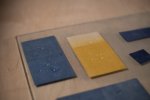
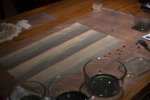
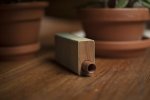
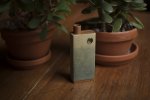
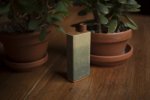
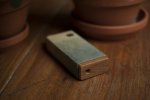
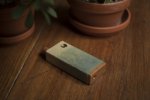
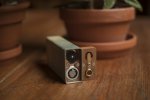
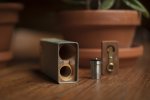
All the colors I'm sure would look great, but I'm partial to the gradient. Looking forward to seeing more from this project!Wrapping went well! Here's the final production quality Toad! The body of this one, as well as probably all of them in the first batch, is local black cherry. The stem is pear, but most likely they'll be glass as stock. I've got a soft spot for this wood stem though...
On the end-grain of the paper sleeve, you can see how the light greenish colour goes all the way through the material. I think the above view is quite nice with this coloured border around the wood top. I imagine with more vivid colours it'll look even more striking.
The stems are interchangeable with the Nomad I and II.
View attachment 10350
View attachment 10351
No more brass on the back like with the Nomads, it's all hidden inside now.
View attachment 10352
View attachment 10353
View attachment 10354
The bottom is magnetic. Spring loaded brass battery contact. And just like the Nomad II, you turn the wooden bottom 180 degrees and re-install to create a hard break in the circuit so that you can carry it in your pocket without worrying about accidentally pressing the button and engaging the heater.
View attachment 10355
I kept the same chunky brass heater module contact ring that's in the Nomad II. I tried a solid 99.9% silver ring, but found that it made no difference... actually the softness of the metal would have likely caused issues down the road with wear and tear.
The brass contact ring sits in the wood without any visible tracks or wires attached. The electrical path is totally hidden for a clean look.
View attachment 10356
I'm trying to decide what colours to go with for the first batch... I may just go with all greens. Or match my fabric case colours, green, blue, yellow, brown, grey. I like the gradient I think... but the solids and two-tones look sweet as well so It's tough to choose!
I've spent so long doing custom orders I forget how hard it is to make these final colour choices, haha!
If I haven’t said already, I’m in.@kanal , not sure yet. I may just dump a batch of 15 or so here on the thread. Anyone who has said or says they're interested in the thread will likely get special favor. This may be okay until I do a more public release.
@3migo , noted! one point for gradients!
With this newest Toad I made the outer shell with a hard acrylic adhesive intead of the wheat starch paste, The final result is practically identical in look and feel... but this acryic makes the shell totally waterproof and just a tad bit more stiff and durable. I think the adhesion strength between the layers is higher as well. Adhesion to the wood is on par with the wheat starch. Both shells are topped with beeswax/mineral oil.
The acrylic is a bit easier to use, less water content, more initial tackiness and faster dry time. Transparency might be a little better with the acrylic.
The acrylic doesn't need to be finished with an infusion of shellac, reducing a step.
Both adhesives are artist top grade, archival. The acrylic is made in Canada by an eco-conscious company (Tri-art).
I am torn. On one hand the acrylic checks a lot of boxes...and if im totally honest it's probably the superior thing to use in terms of durability. But the wheat starch/shellac is a very close second...with the added cool factor of being traditional and totally natural.
Thoughts? How important is the all-natural thing? I mean...at the end of the day these Toads will still have silicon o-rings, acrylic lenses, and PEEK heater module insulators... You simply must go with what is functionally the best material for the job...right!? hmm.
but but but.... i was looking forward to eating my toad skins!



I don't have a strong preference there. If the acrylic makes for a more durable product and is easier to make, I say go for it.@kanal , not sure yet. I may just dump a batch of 15 or so here on the thread. Anyone who has said or says they're interested in the thread will likely get special favor. This may be okay until I do a more public release.
@3migo , noted! one point for gradients!
With this newest Toad I made the outer shell with a hard acrylic adhesive intead of the wheat starch paste, The final result is practically identical in look and feel... but this acryic makes the shell totally waterproof and just a tad bit more stiff and durable. I think the adhesion strength between the layers is higher as well. Adhesion to the wood is on par with the wheat starch. Both shells are topped with beeswax/mineral oil.
The acrylic is a bit easier to use, less water content, more initial tackiness and faster dry time. Transparency might be a little better with the acrylic.
The acrylic doesn't need to be finished with an infusion of shellac, reducing a step.
Both adhesives are artist top grade, archival. The acrylic is made in Canada by an eco-conscious company (Tri-art).
I am torn. On one hand the acrylic checks a lot of boxes...and if im totally honest it's probably the superior thing to use in terms of durability. But the wheat starch/shellac is a very close second...with the added cool factor of being traditional and totally natural.
Thoughts? How important is the all-natural thing? I mean...at the end of the day these Toads will still have silicon o-rings, acrylic lenses, and PEEK heater module insulators... You simply must go with what is functionally the best material for the job...right!? hmm.
but but but.... i was looking forward to eating my toad skins!

Yeah, agree with this. I love the gentle earth tones so a nice earthy red, with the green sage, and the cool river stone blue would all be great options.I think a sunset red would look nice, same shade as that green. I'm just imagining a full on sunset colored gradient shaded Toad.
Ah thank you for clarifying!All wonderfull comments! And just to clarify @attackpoints , The washi is the same, still made of washi, just using a different adhesive. Theres no top coat of acrylic, what you feel on the surface is washi paper infused with a bit of acrylic... which actually feels quite organic surprisingly. The shells are sanded so that they feel buttery soft n smooth.
@xtraclipsforxtrashit , diggin' the sunset vibes!
